 |
|

|
 |
TABLE of CONTENTS
 |
MnDOT crews clean up after another winter storm |
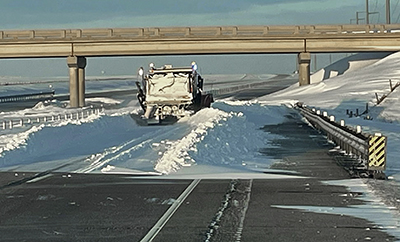
Large snowdrifts blocked many roadways in southern Minnesota, including this portion of I-90 between Worthington and Adrian, seen here on the morning of Thursday, Feb. 23. Photo by Chase Fester |
By Doug Mack
A multi-day snowstorm dropped more than a foot of snow across much of Minnesota, keeping MnDOT’s plow crews and support staff busy yet again in an eventful winter.
The storm began on Tuesday, Feb. 21 and continued through much of the day on Wednesday and into Thursday. Minneapolis-St. Paul International Airport reported a total of 13.4 inches of snow, while parts of southern Minnesota got even more, with the area around Marshall topping 20 inches and North Mankato hitting 18 inches, according to the National Weather Service.
While the snowfall wasn’t nearly as heavy as some Minnesotans had anticipated, it was more than enough to create hazards on the state’s roadways, especially in open areas where wind created large drifts. MnDOT issued no-travel advisories for several counties, including all of District 8, and closed I-90 in the region, along with several state highways, for a period from Wednesday to Thursday.
According to Minnesota State Patrol, from Tuesday until midday on Thursday, there were 384 crashes around the state—far fewer than anticipated.
Media outlets, social media users and others across the state praised MnDOT crews for their efforts to keep roads clear and drivers safe.
“I wanted to send an email as a resident of Minnesota and let you know that the hard work and effort put forth by your staff is recognized and greatly appreciated,” one Minnesotan wrote in an email to Commissioner Nancy Daubenberger. “I am referencing the hard work that is done keeping the roads drivable during the Winter. I was out on the roads Tuesday and Wednesday this week and found the roads to be plowed, salted and in very decent condition considering the blizzard conditions. I know you receive complaints from residents, so I wanted to send this note to make sure it was clear that many of us are grateful for the snowplows and winter workers you oversee.” |
| |
|

|
 |
TABLE of CONTENTS
 |
Public weighs in on statewide public engagement and communications efforts |
By Kayla Dean
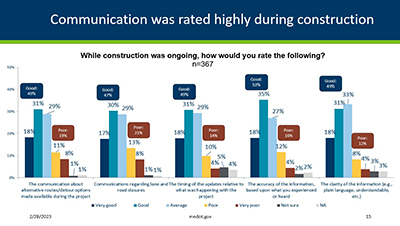
Data from the evaluation of public engagement during the Hwy 61 reconstruction project. Image from Market Research Unit presentation. . |
How well is MnDOT doing at engaging and communicating with the public in project development and during construction projects? In 2022, the Market Research Unit piloted an evaluation project to help answer that question. Market research staff worked alongside district public engagement staff to evaluate six construction projects across the state that had been completed in late 2021. The projects varied by type, location, budget and scale, but all involved some level of public engagement prior to construction.
The team used a standardized evaluation survey to collect public and stakeholder perceptions about MnDOT’s communication and engagement activities as well as the completed project. A total of 2,783 people participated.
Highlights from the findings include:
- Respondents preferred providing project feedback via online communications and engagement options, such as online surveys, emailing MnDOT staff and social media.
- Most respondents (73%) were satisfied with the amount of information they received about the project throughout. Only 25% wanted to receive more project updates and 2% wanted to receive less.
- Using a variety of communication channels is most effective at reaching the masses. Respondents said they were informed about the construction by road signs, newspapers, MnDOT’s website, word of mouth and social media.
- More than two-thirds (64%) of respondents understood the purpose of the project, but almost half (49%) felt that MnDOT was not clear about what their feedback could affect and what had already been decided.
- More than half of the respondents (53%) were satisfied with the construction projects when they were completed.
- Nearly half of the respondents agreed that MnDOT’s projects improved safety, added value to their community, improved accessibility and improved their driving experience. However, only a quarter of respondents agreed that the projects reduced congestion.
There were several things that the project teams and market research staff learned by doing this pilot.
“In District 1, we were interested to see the post-construction survey results for our Grand Marais project,” said Pippi Mayfield, District 1 public engagement and communications director. “We obviously know from our perspective how the outreach, community involvement and construction went, but it’s good to see what the public had to say via the survey. We were pleased with the results. The survey also opened the door for more conversation about mid-project surveys because sometimes people don’t always remember outreach or involvement that took place 2-5 years prior to project competition.”
Similarly, MnDOT’s market research team learned that evaluation of public engagement efforts can be especially effective earlier in the process, rather than rather than after project completion, since engagement typically happens long before construction. For the next phase of this project, they are looking to survey the public closer to the scoping phase. Staff are also interested in creating measures to assess communications and public engagement efforts and outcomes at an agency level.
Survey results and reports for each project are posted on iHUB on the Reports - Market Research page.
As the Market Research Unit continues to evaluate the effectiveness of MnDOT’s public engagement and communications efforts at the activity, project and agency-level, contact Kayla Dean or Nate Lassila or look at Market Research’s iHUB page with any feedback or requests for public-engagement evaluations. |
| |
|

|
 |
TABLE of CONTENTS
 |
MnDOT awards $725,000 in Safe Routes to School grants |
By Joseph Palmersheim
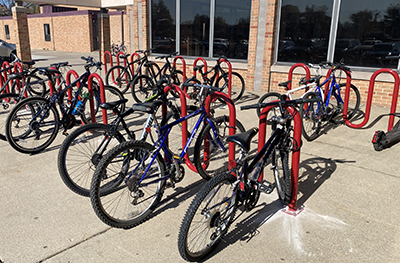
Richfield Public Schools received grant funding last year for its Bicycle Parking Accelerator Project to install high-quality racks for students and community members. The district added 77 bike parking spots last fall at Richfield High School (pictured), Richfield STEM Elementary and the Central Education Center. This spring, the district will install the remaining spots at multiple locations. Photo courtesy Richfield Public Schools
|
Twenty-three communities around Minnesota will benefit from $725,000 from this year’s planning and programming grants that support the Safe Routes to School program. These grants are funded with state and federal Safe Routes to School dollars. Historically, nearly 70% of these funds have supported work within Greater Minnesota communities.
Safe Routes to School is an international program to improve safety and reduce traffic congestion around schools. It does this by making it safer and easier for students to walk and bicycle to school, with an added benefit of increasing physical activity and student health.
Safe Routes to School grants provide for:
- Planning assistance to help communities convene a team, understand key issues, prioritize strategies and identify solutions that fit their local need.
- Boosting existing local programs, such as funding for bike fleet with a trailer to teach children how to ride, and funding for bike parking.
“Children have more opportunities to walk, bike and roll to schools because of the Safe Routes to School program,” said Nancy Daubenberger, MnDOT commissioner. “Thanks to this funding, students across the state can learn how to do these lifelong, foundational activities in a safer setting.”
One example of how Safe Routes to School grant funding can impact a community is Richfield Public Schools’ Bicycle Parking Accelerator Project, a grant-funded initiative to install high-quality racks for students and community members. The district added 77 bike parking spots last fall at Richfield High School, Richfield STEM Elementary and the Central Education Center. This spring, the district will install the remaining racks at multiple locations, including Richfield Middle School, Richfield High School, varsity athletic facilities, Central Education Center and Sheridan Hills Elementary.
“Having visible, well-maintained places to park a bike is one important piece of the puzzle of encouraging bicycle riding,” said Will Wlizlo, a Safe Routes to School coordinator with Richfield Public Schools. “This kind of programming really makes other initiatives sing. This can be a city's investments in bicycle and pedestrian infrastructure, or it can be other programs such as education or encouragement. The whole is greater than the sum of its parts."
Since 2005, MnDOT has awarded more than $60 million in federal and state funds to communities to support Safe Routes to School. The majority of this funding was awarded for infrastructure projects. The remainder was allocated for programs and planning that promote walkable and bikeable communities.
More information on Safe Routes to School is available on the MnDOT website.
Safe Routes to School 2023 Awards:
Planning Assistance
- Oak Ridge Elementary, Eagan
- City of Chaska
- Great Oaks Academy, Farmington
- Warroad Community Development
- City of Plainview
- Anoka Hennepin School District, Dayton
- Circle of Life Academy, White Earth
- Highland Elementary School, Crookston
- Voyageurs Expeditionary School, Bemidji
- Osakis Public School
- Alexandria Public Schools
- Mesabi East School District, Aurora
- St. Cloud Area Planning Organization
Boost
- Rothsay School District
- Dakota County Public Health
- Minneapolis Public Schools
- Safe Kids Grand Forks
- Richfield Public Schools
- Brooklyn Center Community Schools
- Saint Paul Public Schools
- City of La Crescent
- City of Fergus Falls
- Congdon Park Elementary School, Duluth
|
| |
|

|
 |
TABLE of CONTENTS
|
Employee survey deadline extended |
| By Doug Mack The deadline for completing the Employee Engagement and Inclusion Survey, which was emailed to all MnDOT employees in January, has been extended to March 8. The completion rate so far is 35% and agency leadership hopes to increase this rate, the better to understand workplace satisfaction and function, and develop plans to help support employees and foster a respectful workplace.
The last survey, which MMB launched in December 2020, showed that most respondents were satisfied with their job (81%) and most understood the impact of their work (95%). But the survey also highlighted specific areas in which respondents desired change. Based on this survey feedback, MnDOT has worked to implement or expand several programs and initiatives, as detailed in the Feb. 1 issue of Newsline.
The survey takes about 15 minutes to complete. Employees who have not received a link to the survey via their work email should contact Management Analysis and Development, also known as MAD, at 651-259-3800 or Management.Analysis@state.mn.us. |
| |
|

|
 |
TABLE of CONTENTS
 |
MnDOT launches first multimodal trip planner to focus on rural transportation services |
By Joseph Palmersheim
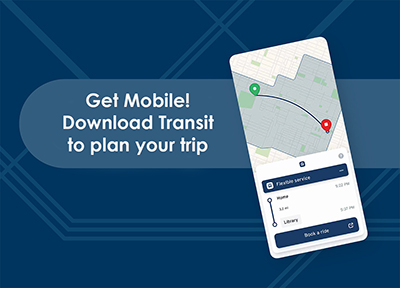
The Transit app provides trip planning and payment technology for southern and western Minnesota.
|
When drivers want to take a trip across the country, they can choose from a variety of travel apps to help them plan. But what if the trip they want to take is from Mankato to New Ulm, or within their own community, using non-personal transportation?
MnDOT launched a pilot project on March 1 to offer trip planning and payment technology for daily trips in selected regions of the state, including areas outside large cities (where local transit systems often have their own apps). Residents and visitors in southern and western Minnesota now have the ability to plan and, in some cases, pay for public transit and intercity bus trips by using the Transit app.
“Much of the development of shared mobility technology has focused on highly urbanized areas, where residents often have a lot of choices, from buses and light rail to taxis, ridehail, bike share and scooters,” said Elliott McFadden, who serves as MnDOT’s Greater Minnesota Shared Mobility program coordinator. “In a rural setting, the number of choices are much more limited, so knowing what is available and when is critically important to mobility and quality of life. Our Mobility-as-a-Service platform puts trip planning and payment technology into the hands of riders who would not otherwise have access to this technology.”
MnDOT started work on the Mobility-as-a-Service project in spring 2020. Greater Minnesota Local Human Service-Public Transit Coordination plans identified trip planning and electronic payment as important new services to improve public transit service delivery and rider satisfaction. A Federal Transit Authority grant allowed MnDOT and its project partners to jumpstart the process of implementing the technology in Greater Minnesota.
Cambridge Systematic, MnDOT's technology partner on the pilot project, developed a data aggregator and data warehouse site to store service information like timetables, stop locations and real-time vehicle location information. The project uses data standardization to make it easy to share the information and allow vendors to participate.
Transit, a free app available for download in Google Play or the Apple App Store, is used in more than 300 cities around the world. It allows users to see route and travel options for public transit and connecting services. Select transit agencies will also have in-app ticketing, allowing riders to pay for fares electronically and show their device to bus drivers to ride.
“Transit is a popular multimodal trip planning app that is already available in the Twin Cities and Duluth,” McFadden said. “They bring a well-tested platform and will be the first major trip planner with ability to show rural public transit services, which often operate more like a ride hail service with curb-to-curb services that operate on demand.”
The pilot will run through April 2024 and is funded by two innovation grants from the Federal Transit Administration, at a cost of $1.9 million. Researchers from the University of Minnesota will study both of the projects to help determine whether this technology should be scaled to the rest of the state, with the goal of better informing future public transit investment in Greater Minnesota.
Participating transportation providers include (* indicates in-app ticketing will be available):
- Brown County Heartland Express
- Central Community Transit
- Jefferson Lines (by mid-March)
- Land to Air
- Morris Transit*
- Mankato Transit System*
- Minnesota River Valley Transit
- Prairie Five RIDES
- Rochester Public Transit (by the end of March)
- Rolling Hills Transit*
- SMART*
- The Otter Express*
- Tri-CAP*
- TRUE Transit
- UCAP Community Transit
|
| |
|

|
 |
TABLE of CONTENTS
|
Staffing updates |
Bonnie Wohlberg is new acting director of human resources
Bonnie Wohlberg has taken on a new role as MnDOT’s acting director of human resources, effecting Feb. 15. Wohlberg had previously served as the agency’s staffing manager since 2015 and has worked for more than 30 years with the State of Minnesota in a variety of human resources positions.
She is a certified Hay rater for the State of Minnesota and has a bachelor’s degree in psychology from the University of Minnesota.
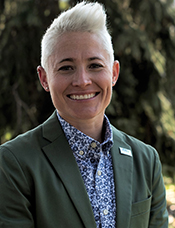
|
Tara Olds is new CAV-X director
Tara Olds has accepted the position of CAV-X director. Olds has worked with CAV-X for the last three years as both deputy director and interim director and at MnDOT for 15 years, including roles in engineering, planning, policy, construction, project management, community engagement, traffic safety and emerging technologies.
She has a bachelor’s degree in civil engineering from the University of Iowa and a Master of Public Affairs degree from the University of Minnesota’s Humphrey School of Public Policy. |
| |
|

|
 |
TABLE of CONTENTS
|
MMB and MNIT offer more options for employee self-identification |
By Doug Mack
In 2022, Minnesota Management and Budget and Minnesota IT Services partnered with the statewide Employee Resource Group MNclusive to give employees more options to describe their individual identities. For the first time, employees had three options from which to choose for their sex: Female, Male, or Other. They could also voluntarily enter their gender identity from a wide range of options.
The listed options have now expanded to include:
- She/Her/Hers
- She/They
- He/Him/His
- He/They
- They/Them/Theirs
- Xe/Xem/Xir
- Ze/Hir/Hirs
- Ze/Zir/Zirs
- Address me by name
As of Feb. 18, employees who specify any of these options in Self Service will see them displayed in Outlook, Teams and other work-related Microsoft applications. Employees can also select Any/All or No preference, Not in List, or Prefer not to say; these options will not be displayed in Outlook or other applications.
This summer, employees will also be able to set their preferred first name to display in Microsoft products such as Outlook and Teams. All new employees will have the option to provide their preferred name during the onboarding process. (Setting a preferred first name will be done by contacting human resources, not through Self Service.)
“MnDOT Q&A is extremely proud to be a part of these changes with Self Service,” said Jen Parshley and Alex Stoiaken, co-chairs of the Q&A employee resource group. “This has been something we have wanted for a while as we recognized how important it is for individuals to feel respected and valued in the workplace. Imagine showing up day after day to work and people don’t use your chosen pronouns or chosen name? How would that make you feel if you had to constantly correct others? Would you want to keep showing up? Think of the impact too on new employees. This is a big sign of a welcoming and inclusive workspace. These changes give us the opportunity to share about ourselves and to learn how we should address our coworkers. We are grateful for all the work that led us here."
Employees are not required to provide sex, pronoun, or gender identity data in Self Service. There are no prerequisites or requirements to change this information. Employees may update Self Service on their own without any documentation or approval process. The roughly two dozen employees whose pronouns were added earlier through a manual process for specific software will need to enter their pronouns through Self Service for them to continue to display.
Setting up the listed pronouns is a simple process:
- Sign in to Self Service.
- Navigate to the Gender Details page. Path: About Me > Who Am I > Gender Details
- Select the Gender Details row.
- To make updates to any of the fields (Sex, Pronoun, Gender Identity), use the dropdown or magnifier icon to view the list of options. Select a value and then select the Save button. If you do not wish to make updates to your Gender Details, select the Cancel button.
According to MNIT, if employees have made changes in self-service, it may take three to five days to fully cycle through the state technology system. If pronouns are not showing after this period, submit a ticket to MNIT Service Delivery (the gold surfer icon on employee desktops or email itservicedesk.dot@state.mn.us) or call 651-355-0200.
For more information about pronouns in the workplace, see the workplace resources section of the Q&A page. |
| |
|

|
 |
TABLE of CONTENTS
|
Updated infographic shows the latest MnDOT stats |
By Doug Mack
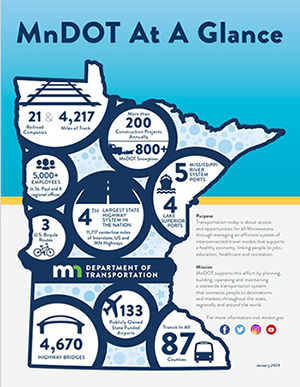
MnDOT at a Glance, freshly updated for 2023.
|
MnDOT at a Glance, a one-page infographic that provides basic information about the agency, has recently been updated to reflect the most current statistics. The new graphic reflects the growth of the agency, from 4,800 employees in 2018 to more than 5,000 now, and changes to Minnesota’s transportation system, including an increase in the number of U.S. bicycle routes (three, up from two), and slight decreases in the number of centerline miles of interstate, U.S., and state highways (11,717, down from 11,856).
The graphic, which is displayed at public events like the Minnesota State Fair, also offers short overview of the agency’s operating principles, including its official purpose and mission statements and highlighting MnDOT’s role in “planning, building, operating and maintaining a statewide transportation system that connects people to destinations and markets throughout the state, regionally and around the world.”
MnDOT at a Glance is available as a high-resolution, printable PDF that is publicly available through eDocs. |
| |
|

|
 |
TABLE of CONTENTS
|
Metro workforce outreach team takes MnDOT to the community |
By Marney Curfman, workforce outreach coordinator, Metro District
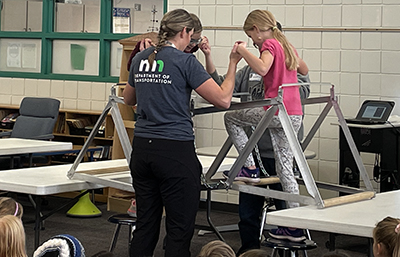
MnDOT employee Cynthia Morgan leads students in a bridge-building exercise at Kasson-Mantorville Public School. Metro District workforce outreach staff members attended the event as part of activity observation in District 6. Photo by Marney Curfman
|
Metro’s workforce outreach staff are working to spread awareness and recognition of MnDOT to a wider segment of the Twin Cities population. The team’s goal is to help expand the average Minnesotan’s perception of the agency, going beyond the services MnDOT provides to consider the breadth of roles employees serve to ensure Minnesota’s multimodal transportation system maximizes the health of people, the environment and the state’s economy.
This team’s specific role is to provide Metro District outreach by:
- presenting information about MnDOT at community events
- attending career events and interacting with attendees
- conducting STEM outreach in school classrooms
- coordinating and directing tours of MnDOT facilities for school-aged children
Workforce outreach staff have been working to find community and school contacts, connect, propose outreach activities and register for existing events.
One recent example: In January, staff presented to career classes at Irondale High School, talking with students about careers with MnDOT and the agency’s broader work. These activities included MnDOT trivia, a question-and-answer period, and giveaways of MnDOT pens and other small items. The presentation was well-received by the students and their teacher, and the workforce outreach staff has been invited back to Irondale and Mounds View High Schools to participate in their “What’s Next” Career Fairs.
The workforce outreach team is starting to schedule various spring and summer events and is looking for employees across the agency to help with these awareness and recruitment efforts. The team is looking for MnDOT employees interested in sharing their stories at community or school events, or reaching out to their alma maters to suggestion a presentation. There’s a particular need, based on existing community requests, for bilingual employees to join the workforce outreach staff at events.
To learn more about how to help, contact Marney Curfman or Cyndi Camarillo. |
| |
|

|
 |
TABLE of CONTENTS
|
District 7 mourns loss of Matt Young |
By Doug Mack
Matt Young, District 7, passed away on Jan. 31 at the age of 44. He had worked for MnDOT since 2010, starting as a transportation specialist in land management and later being promoted to other roles including, most recently, engineering specialist senior in project management.
“It was apparent that Matt cared deeply about his projects, in particular his Hwy. 93 grade raise project near Henderson,” said Forrest Hasty, District 7 project management supervisor. “Matt made it a point to meet with every landowner to discuss the impacts of the project regardless of how uncomfortable the conversation was going to be. He was a well-respected employee for MnDOT—not only was Matt a valued part of the District 7 family, he was a friend to many, was loved, and will be missed tremendously.”
Outside of work, Young enjoyed hunting, fishing, gardening and making maple syrup with his family.
Young is survived by his wife, Anna; his daughters, Katelyn and Meg; and other relatives. |
| |
|

|
 |
TABLE of CONTENTS
|
On the Job: A.J. Farrow maintains bridges and keeps roads clear |
By Doug Mack
In his six years at MnDOT, A.J. Farrow has filled several different roles, including highway maintenance, bridge maintenance, and plow driver.
What are your day-to-day tasks?
My day-to-day tasks change often. However, we maintain more than 150 bridges, overpasses, pedestrian bike ramps and soundwalls in the Metro/southwestern area. We get to enjoy the variety of Plymouth, Long Lake, the Excelsior area and trunk highways. We mostly repair large or minor vehicle hits or accidents that cause damage to MnDOT property within our jurisdiction. These may be requested by “yellow tags” or work orders from state troopers or authorities that govern the areas.
We also fabricate custom frames, holders, modifications and equipment for truck shops, vehicles and mechanisms that are special requests. We often use metals and machining or welding techniques. When it’s not snow and ice season, we provide support to bridge inspectors, perform maintenance on bearing plates, pour concrete and epoxy bridges decks.
How has your job changed since your first started?
Since I’ve started, I have been trained to weld. I have also begun training to do safety inspections; I’ve done High Angle Rescue training; and I’ve been certified on the 30-foot snooper. A lot of things have to do with dangerous heights over the rivers and creeks that we drive over every day.
Is there anything about your job that might surprise other people (either inside or outside MnDOT)?
I believe that my fear of heights may not surprise people, but what probably does is the fact that the bridge maintenance position involves around six different trades. The average bridge worker position has a multitude of roles and must solve problems, work efficiently and provide diverse skills to complete projects.
What are your interests or hobbies outside your work with MnDOT?
I enjoy horsepower! I love to ride horses and Harleys and I enjoy my days at the lake and barbeques. But most of all, I enjoy showing up to MnDOT events and representing the best career choice I have ever made!
Do you or a co-worker have an interesting job to share with readers? Send us your ideas, and we’ll contact you for more information.
Recent employee profiles:
|
 |
|
|
|



